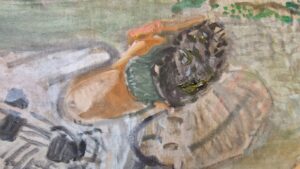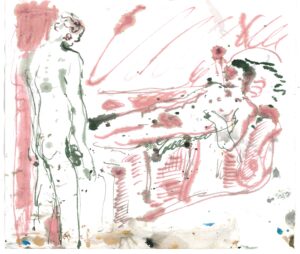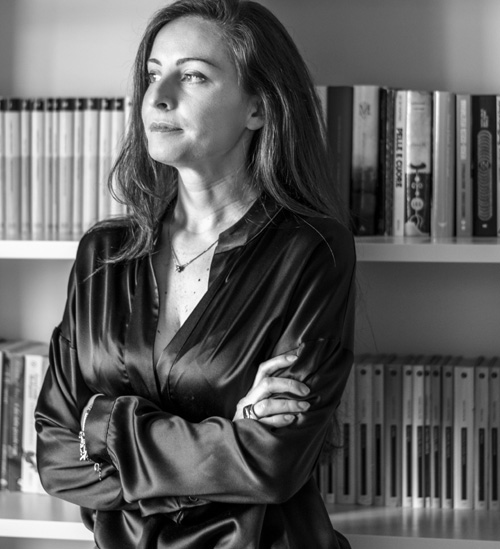If every painting originates from an unprovable and unproven postulate, Giulio Catelli’s exists to be gently distorted and softened. However, the artist’s possession of the sheet and canvas is like a slab of wax, with no boundary between air and matter, so the outlines are lost in a hatched texture that makes the subjects fragile and elusive captivating fables, moved by strange surface osmosis.

Giulio Catelli, Ragazzi sotto ponte Sisto, 2023, 120 x 140 cm, oil on canvas, courtesy the artist and Galleria Richter Fine Art, Rome
It is easy to see that in mixing individual brushstrokes like flutters, driven by improbable gusts of wind, the painting is generated by a meticulous catastrophe intent on representing a honest and pure world. So, the themes move as disorderly forms of dynamic vitality, typical of a rhythm closed to new discoveries, as if they had always been there under our eyes, simply needing to be chosen, such as to exercise us in the question: what trace is there in the mind and sensibility of Catelli’s means and purposes? Well, it is the sense of reality that keeps the artist tied to the consistency of the image; he is there, struggling in a frenzy between the denial of a pre-established spatiality that he does not intend to let dissipate, except by marking large color slashes, in which the lines tearing through the forms are inserted as things already done. Regarding his recent production, the artist reveals that the constant change presents no negative aspect, on the contrary, it is desirable, so in the works exhibited at the show titled Chirping Garden – which will open on October 26, 2023, as a part of a residency project started in 2022 – which also celebrates the fiftieth year since the foundation of the John Cabot University in Rome, the subjects on display are decent, affectionate, incapable of uncontrollable passions, rarely active and more often lazy.

Giulio Catelli, Tre studenti sul divanetto, 2023, 24 x 30 cm, oil on canvas, courtesy the artist and Galleria Richter Fine Art, Rome
Yet, what is proposed by John Cabot University is an invitation to understand the problematic judgment that, in a certain way, opens, more or less consciously, new possibilities for engaging in research, to the extent that we wonder if every work is generated by an irreversible and new maturation of the artist. I don’t doubt that the production on display is skillfully contained in a harmonious box that encompasses the environment and the areas adjacent to John Cabot University, even though Catelli shows himself to be lyrically attentive to the rudimentary delight of the human body, especially the feet, legs and head, as they are recognized as the backbone of the physical. It is precisely their articulate movement that inhabits space, so it is of fundamental importance to capture this aspect with tactile intelligence, just as when he stubbornly aims to capture the movement of birds with matte hilarity on the lawn of Villa Farnesina, from a unique point of spatial observation that the University provides. After what has been said, it is safe to assume that the artist knows how to write well and not simply transcribe what is placed before him or recite by heart, so much so that with his works on display, one feels a bit taken by the throat or at least relieved of the duty to say yes or no to the question of whether one recognizes that place now represented in its simplest and most experimental form.

Giulio Catelli, Ragazzi sotto ponte Sisto, dettaglio, 2023, 120 x 140 cm, oil on canvas, courtesy the artist and Galleria Richter Fine Art, Rome
Let’s say everything at once: Catelli intuits and crushes this recognition under the weight of his painting, continuing to be struck by uncertainty because he has understood that characterizing his expressions is a coessential fact. He immerses himself in the work and its warm stasis, focusing on the centrality of the subjects and never sliding into unbearable aestheticism. Therefore, the artist’s story is one of a gently distorted and embellished search for grace, as he is fully aware, without any hesitation, that he has fallen in love with the problem of his painting. Perceiving the worship of this enigma, sometimes he barely squints his eyes and caresses the backgrounds of the canvases with his hands, colors arranged like fleshy tights clouds almost ready to expand elastically. Well, this is an enticing quality that coincides with his mimetic voice, likely typical of a painter marked by childlike cleverness and intelligent and natural eccentricity, of which perhaps he is unaware. It goes without saying that his cautious and precise eye enjoys playing with the preferred view upside down, always full of unexpected continuity, and such a choice inevitably leads to the failure to identify a main center. Sometimes the subject is duplicated in the same scene in a candidly artificial posture, and at other times, he leaves it free, without defining any difference between the protagonist and the extra.

Giulio Catelli, Ragazzi sotto ponte Sisto, dettaglio, 2023, 120 x 140 cm, oil on canvas, courtesy the artist and Galleria Richter Fine Art, Rome
This unique ability to conceive humorous and enigmatic views, where one barely perceives a hint of an abyss, emerges even more in the selection of drawings that are much more appealing than the paintings on display, some of which are collected in a fanzine in 150 copies curated by John Cabot University and the artist. In these drawings, the density of what is depicted has its own warmth: one could reflect on the weight that drawing holds for the artist, an escape route, or a private relief. There is no doubt that for Catelli, such an exercise is fundamental in restoring a specific and fateful space to his pictorial problem, which now becomes clear, and it is the manipulation of shadow and the elasticity of space. This practice is clever even though it is not used to paint complete figures but only to hint at their vivacious traits. This is done with his dear cat, Miki: Catelli is aware that he does not want to reproduce it exactly as it appears, and as a much-preferred act, he makes it come to life and be reborn every time he portrays it, bringing it forth almost blindly in the abandonment of a blank sheet of paper, where the ink fluctuations behave eccentrically like the wind does with the sea.

Giulio Catelli, Sul divano, 2023, 20 x 24 cm, china on paper, courtesy the artist and Galleria Richter Fine Art, Rome
In all these brilliant sheets, the ink sketches unexpectedly take on the flavor of a barely hinted joke, with hints of both fatal and childlike wisdom. Not for the subjects they portray, nor for the way he approaches them, but rather for the moments, all chosen with the quiver of a knowing childhood. The artistic impulse, always controlled by the vigor of the lines, exhibits an energy of movement functional to the invention of a joyful hand. To verify this intuition, it would be truly useful to rotate and start studying the sheets in all directions, as they may appear as candid and neurotic scribbles. However, be sure to understand this view not as a thoughtless action, but as a pastime typical of a reasoning ability to manage one’s inventive freedom, which connects all the lines in a logical connection, and the viewer’s sole task is to discover the rules, if there are any. So, even though some corners remain untouched, the soft stroke records various oscillations, never a result of regret, which is why the line is never just a line, but rather a clumsy form, tending to be drawn into the watercolor patches or the white background in which it appears.

Giulio Catelli, Nei giardini, 2022, 33 x 22.5 cm,china on paper, courtesy the artist and Galleria Richter Fine Art, Rome
In a certain sense, it’s worth noting that the collection of drawings presented here are vulgarized subjects, narrated as if in miniature parables of raw charm. In most cases, the figures do not turn towards us, indicating that they have other matters to attend to. Catelli, therefore, does not concern himself with outlining scenes but rather is focused on defining moments. This is a stark and striking choice for a painter, as the narrative character is only revealed later, and the depicted action becomes clear only through cleverly didactic titles. This very aspect sets Catelli’s drawing practice apart from the typical work of another artist, as these sheets contain many narrative hostages that he studies with a curious eye and alters as the wind blows, infatuated with their own form, something fatal on a deceptively smooth pictorial body.
Info:
Giulio Catelli, Chirping Garden
Art history society, John Cabot University, Roma
Via della Lungara, 233, 00165, Roma
From 26/10/2023
https://www.johncabot.edu/| arthistorysociety@johncabot.edu

Maria Vittoria Pinotti (1986, San Benedetto del Tronto) is an art historian, author, and independent critic. She currently is the coordinator of Claudio Abate’s photographic archive and Manager at Elena Bellantoni’s Studio. From 2016 to 2023 she was the Gallery Manager in a gallery in the historic center of Rome. She has worked with ministerial offices such as the General Secretariat of the Ministry of Culture and the Central State Archive. Currently, she collaborates with cultural sector magazines, focusing on in-depth thematic studies dedicated to modern and contemporary art.






NO COMMENT